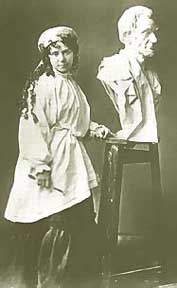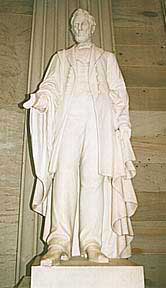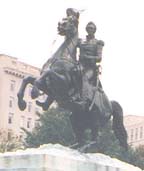
Vinnie
Ream:
Sculpting a
Name for Herself in History
  If
you go to the U.S. Capitol you may see a full-length,
marble statue of President Abraham Lincoln in the
Rotunda, and beside this work the name of the artist,
Vinnie Ream. This name also appears beside the
full-length, bronze statues of Iowan governor Samuel
Jordan Kirkwood and Cherokee hero Sequoyah, both of which
are located in the Capitol's Statuary Hall. Though the
name may not be familiar to many visitors of the Capitol
today, during the post-Civil War days "Vinnie
Ream" was the talk of the town. If
you go to the U.S. Capitol you may see a full-length,
marble statue of President Abraham Lincoln in the
Rotunda, and beside this work the name of the artist,
Vinnie Ream. This name also appears beside the
full-length, bronze statues of Iowan governor Samuel
Jordan Kirkwood and Cherokee hero Sequoyah, both of which
are located in the Capitol's Statuary Hall. Though the
name may not be familiar to many visitors of the Capitol
today, during the post-Civil War days "Vinnie
Ream" was the talk of the town.
Vinnie Ream was born in Wisconsin in 1847, but in the
first year of the Civil War moved to Washington, D.C.
when her father, a former surveyor, relocated the family.
In 1862, though not yet 15 years old, she managed to help
the family financially by obtaining a position at the
Post Office.
During the next year, Vinnie visited the studio of Clark
Mills who casted in bronze the equestrian statue of
Andrew Jackson that stands in Lafayette Park, across from
the White House. She impressed the artist by sculpting in
clay a medallion of an Indian chief's head and was taken
in as his part-time pupil. Soon after, she began
sculpting busts of politicians who frequented the studio.
In 1864, the precocious young artist requested to sculpt
a bust of President Abraham Lincoln, and the successful
outcome of this project encouraged Vinnie to pursue a
prestigious commission to sculpt a full-length statue of
the President. Her attainment of the $10,000 commission
in 1866 was not easily won, however, as the 19-year-old
was met with resistance by those who criticized her
skill, age, gender, charm, and physical beauty. But
Vinnie emerged as the victor with the successful
completion of this project in 1870, and the unveiling of
her masterpiece in the Capitol during the first month of
the following year.
Around this time, Vinnie had become the sole provider of
the family, and the funds from her commission were now
depleted. Despite continually disparaging remarks by her
critics, the pragmatic and tenacious Miss Ream pursued a
commission in 1873 to sculpt a full-length statue of
Admiral David Farragut, three years after the Civil War
hero's death. Vinnie sought the assistance of the
admiral's widow, politician friends, and General William
Tecumseh Sherman, her most dedicated supporter. Her
ultimate triumph earned Vinnie the $20,000 commission,
and her 10-foot-high plaster model for the bronze casting
was completed in 1878.
Vinnie Ream married Lieutenant Richard Hoxie in 1881,
ending her career as a sculptress to become a traditional
Victorian wife and later the mother of their only child,
Richard. Twenty years later however, her husband
witnessed the effects on Vinnie's health by denying her
artistic self-expression. Hoxie allowed his wife to take
up sculpture again, and in 1906 Vinnie created the statue
of Civil War governor Kirkwood that was presented in
bronze to the Capitol in 1913. In 1912, she was asked by
the State of Oklahoma to create a bronze statue of
Sequoyah, who had developed the written language of the
Cherokee then served as a leader for his tribe. But just
before the completion of this work, Vinnie collapsed and
died of kidney disease. George Zolnay, friend and
sculptor, completed the statue and was later commissioned
to sculpt a bronze bas-relief for Vinnie's gravesite in
Arlington National Cemetery.
Though the life of the sculptress had come to an end,
through her works Vinnie Ream will be remembered, along
with the heroes whom she immortalized in bronze.

Above
left: Photo of Vinnie Ream and bust of Abraham Lincoln
from the State Historical Society of Wisconsin. Above
right: Photo of Vinnie Ream's statue of Abraham Lincoln
in the U.S. Capitol by CNO.
Clark
Mills: Sculpture by the Mentor of Vinnie Ream
  Sculptor Clark Mills made this
plaster life mask of President Abraham Lincoln (pictured
left) in 1865, just before the President's untimely
death. Mills's equestrian statue of President Andrew
Jackson (pictured right) was cast in bronze in 1853 with
melted metal from a captured British cannon. The statue
was placed in Lafayette Park across from the White House
where it still remains today. Sculptor Clark Mills made this
plaster life mask of President Abraham Lincoln (pictured
left) in 1865, just before the President's untimely
death. Mills's equestrian statue of President Andrew
Jackson (pictured right) was cast in bronze in 1853 with
melted metal from a captured British cannon. The statue
was placed in Lafayette Park across from the White House
where it still remains today.

Above
left: Photo of Abraham Lincoln's life mask in the
National Portrait Gallery by CNO. Above right: Photo of
Andrew Jackson's equestrian statue in Lafayette Park by
CNO.

Journal Index | Previous
Page | Next
Page
Back | Home
Copyright © 2001 - 2009 1st Dragoon's Civil War Site. All rights reserved.
Spider
Map Index
|


 If
you go to the U.S. Capitol you may see a full-length,
marble statue of President Abraham Lincoln in the
Rotunda, and beside this work the name of the artist,
Vinnie Ream. This name also appears beside the
full-length, bronze statues of Iowan governor Samuel
Jordan Kirkwood and Cherokee hero Sequoyah, both of which
are located in the Capitol's Statuary Hall. Though the
name may not be familiar to many visitors of the Capitol
today, during the post-Civil War days "Vinnie
Ream" was the talk of the town.
If
you go to the U.S. Capitol you may see a full-length,
marble statue of President Abraham Lincoln in the
Rotunda, and beside this work the name of the artist,
Vinnie Ream. This name also appears beside the
full-length, bronze statues of Iowan governor Samuel
Jordan Kirkwood and Cherokee hero Sequoyah, both of which
are located in the Capitol's Statuary Hall. Though the
name may not be familiar to many visitors of the Capitol
today, during the post-Civil War days "Vinnie
Ream" was the talk of the town.
 Sculptor Clark Mills made this
plaster life mask of President Abraham Lincoln (pictured
left) in 1865, just before the President's untimely
death. Mills's equestrian statue of President Andrew
Jackson (pictured right) was cast in bronze in 1853 with
melted metal from a captured British cannon. The statue
was placed in Lafayette Park across from the White House
where it still remains today.
Sculptor Clark Mills made this
plaster life mask of President Abraham Lincoln (pictured
left) in 1865, just before the President's untimely
death. Mills's equestrian statue of President Andrew
Jackson (pictured right) was cast in bronze in 1853 with
melted metal from a captured British cannon. The statue
was placed in Lafayette Park across from the White House
where it still remains today.